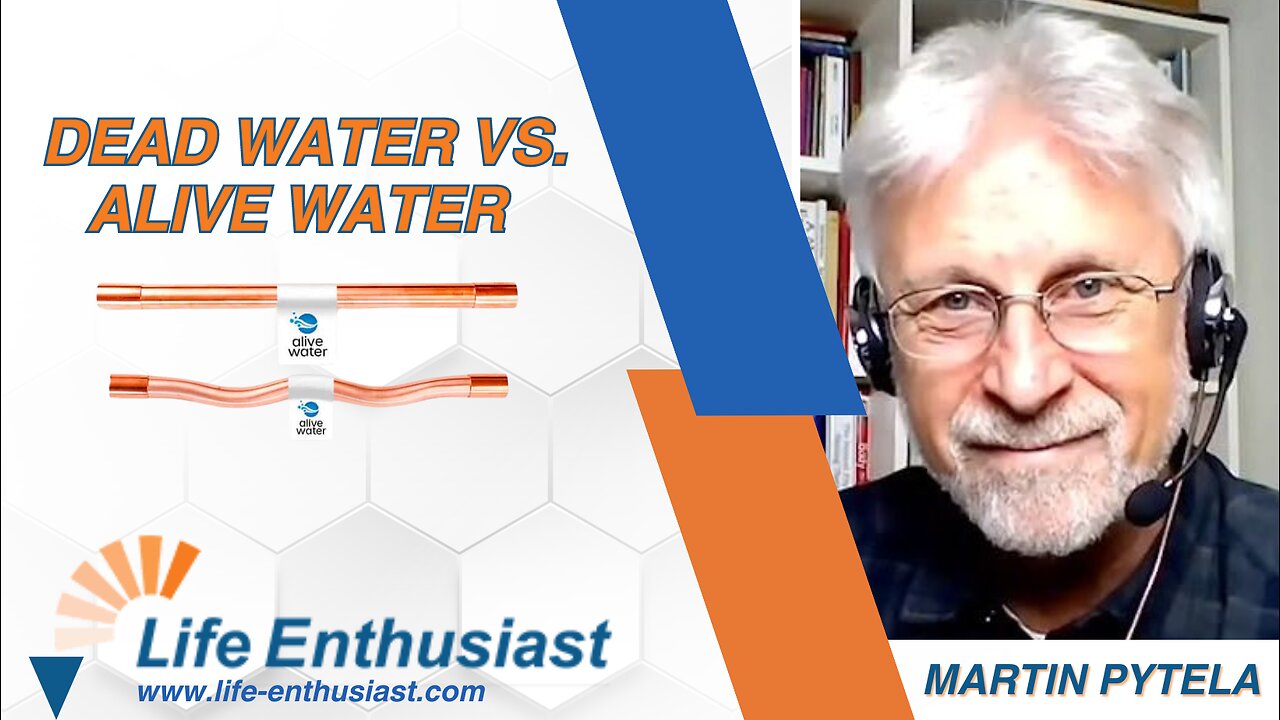Premium Only Content

Dead vs. Alive Water: Techniques for Proper Water Structure and Health
Water, often seen as a simple, everyday necessity that flows from our taps, holds far more complexity and significance than we may realize. Far from being just H2O, water exhibits unique properties that influence not just our environment but also our health. In this article, we'll delve into the hidden facets of water, exploring how its molecular structure and behavior can impact everything from hydration to cellular function.
The Unique Properties of Water
1. Bipolar Nature and Liquid Crystals
Water molecules are bipolar, possessing both a positive and a negative side. This bipolarity causes them to behave like tiny magnets, enabling them to connect and form latent liquid crystals. These liquid crystals are not random but are structured based on the water's exposure. For instance, snowflakes exhibit hexagonal structures that tell the story of water's journey and environment before freezing. Each snowflake, in its uniqueness, serves as a testament to water's ability to memorize and retain information about its past.
2. Water as a Memory Device
One of the most fascinating properties of water is its ability to act as a memory device. Homeopathy leverages this concept, suggesting that water retains the "memory" of substances that were once dissolved in it, even when diluted to the point where no molecules of the original substance remain. This memory effect hints at water's capacity to form clusters that store this information, impacting its interactions and effectiveness in various applications.
Hydration and Cellular Function
1. The Role of Aquaporin Channels
Hydration within the human body operates through tiny channels known as aquaporins. For water to be effectively absorbed by our cells, it needs to pass through these channels in a single-file manner. Large clusters of water molecules are unable to do this, leading to irrigation rather than true hydration. Therefore, breaking up these clusters becomes essential for improving the body's hydration levels.
2. Devices for Better Hydration
To aid in this process, various devices have been developed. These devices work by discharging the energies that cause water molecules to cluster. One way to observe the effectiveness of these devices is through the NMR 17 O test, a resonance test that measures cluster size. Smaller, unclustered water molecules are better at nutrient transportation and toxin removal, improving overall cellular hydration.
Enhancing Water Quality
1. Surface Tension and Dissolution
Devices that affect water's surface tension can significantly enhance its ability to dissolve substances. Lower surface tension means more efficient dissolution, which is particularly beneficial for nutrient absorption and waste elimination.
2. Oxidation Reduction Potential (ORP)
The ORP of water indicates its ability to act as an antioxidant. Water with a negative ORP supports anti-aging processes by combating oxidative stress within the body. Negative ORP values make water more favorable for maintaining cellular health and longevity.
3. pH Balance
Achieving the right pH balance in water is crucial for health. Ideal bodily pH is slightly alkaline, around 7.35. Properly treated water can help in maintaining this pH balance, preventing the body from becoming too acidic, which can lead to various health issues.
Real-World Application: Structured Water
1. Plant's Role in Structuring Water
Plants naturally structure water. When you consume fresh juices like carrot or cucumber juice, the water within is already optimally structured by the plant. However, this is not the case with tap water. As it travels through pipes, it experiences laminar friction, where water at the pipe walls is slowed down while the central flow rushes ahead. This creates a build-up of static energy in the water, rendering it less effective for hydration upon exiting your tap.
2. Methods to Structure Water
To counteract this, there are various methods to discharge excess static energy and restructure water. Static discharge gadgets, crystals like amethyst and quartz, and devices made from silicates called laminar crystals are some examples. Another effective method is running water through vortices or cascades, which helps in breaking down clusters and restoring their natural structure.
Conclusion
Water's simplicity is a facade for its underlying complexity. Understanding the molecular behavior, memory effects, and implications for hydration and health transforms our relationship with this essential element. By leveraging modern technology and natural structuring methods, we can enhance water quality, optimizing its benefits for our well-being. So next time you take a sip, remember that water is much more than a thirst quencher—it's a key player in your overall health.
10 Lessons Discussed In This Episode
1. Molecular Structure of Water
Water molecules exhibit bipolar characteristics with distinct positive and negative sides, allowing them to form latent liquid crystals through interconnections.
2. Water’s Memory Capacity
Comparable to a hard disk, water retains the memory of past exposures. This principle is applied in homeopathy, where water remembers substances even when highly diluted.
3. Hexagonal Snowflake Structures
The unique hexagonal structures of snowflakes demonstrate how water molecules stack differently based on their environmental exposures, illustrating water's structural diversity.
4. Hydration Through Aquaporin Channels
Human cells only absorb water that passes through aquaporin channels in a single file. Large clusters of water molecules are ineffective for cellular hydration.
5. Breaking Water Clusters
To enhance hydration, it's crucial to break up tightly clustered water molecules. Devices designed to discharge built-up energy aid in de-clustering these molecules.
6. Surface Tension and Dissolution
Lowering the surface tension of water enhances its ability to dissolve substances, improving the transport of nutrients and the removal of toxins in the body.
7. Oxidation Reduction Potential
Water with a negative oxidation-reduction potential (ORP) supports antioxidant functions. This reduces oxidative stress, contributing to anti-aging and cellular protection.
8. Proper pH Balance
Structured water aligns the pH towards a slightly alkaline state (around 7.35), which is optimal for human health. Tap water often lacks this balance, making it less beneficial.
9. Laminar Friction in Pipes
As water moves through pipes, it experiences laminar friction, causing a buildup of static energy. This static energy must be discharged to improve water's hydrating properties.
10. Methods to Structure Water
Water can be restructured using mechanical devices or natural processes like vortexing. Devices such as laminar crystal gadgets or vortex pipes help discharge excess energies and properly structure the water for better use.
Fun Facts:
1. Bipolar Water Molecules:
Water molecules are bipolar, meaning they have a positive and a negative side, which allows them to connect and form latent liquid crystals that change based on what the water has been exposed to.
2. Unique Snowflakes:
Each snowflake has a unique hexagonal structure due to the way water molecules stack together, providing a fascinating example of how water's molecular arrangement can vary.
3. Enhanced Hydration Benefits:
Properly structured water not only improves hydration but also enhances the transport of nutrients to cells and the removal of toxins, making it significantly more beneficial than regular tap water.
Connect With us:
Website:
https://www.life-enthusiast.com/
https://www.life-enthusiast.com/articles/product_brand/exsula-superfoods?utm_campaign=cherub&utm_medium=youtube&utm_source=exsula-superfoods
Facebook:
https://www.facebook.com/LifeEnthusiastContact
Twitter:
https://twitter.com/lifentco
-
 1:58:16
1:58:16
Badlands Media
19 hours agoBaseless Conspiracies Ep. 146
66.9K10 -
 LIVE
LIVE
Drew Hernandez
10 hours agoTRUMP SECURES SETTING MEET BETWEEN PUTIN & ZELENSKYY
661 watching -
 5:06:26
5:06:26
SpartakusLIVE
7 hours agoSpartan HERO here to MOTIVATE the MASSES
49.5K -
 1:27:19
1:27:19
Badlands Media
19 hours agoCulture of Change Ep. 117: DARPA, Downloads & the Roots of the Narrative
52.5K5 -
 LIVE
LIVE
BubbaSZN
15 hours ago🔴 LIVE - MAFIATHON (COMPLETING THE MAFIA SERIES WITHOUT ENDING STREAM)
247 watching -
 2:50:02
2:50:02
TimcastIRL
5 hours agoTrump Calls Putin During Zelenskyy White House Visit, European Leaders Praise Trump | Timcast IRL
178K60 -
 1:54:34
1:54:34
FreshandFit
10 hours agoBrandon Carter Returns
45.1K5 -
 8:24:47
8:24:47
MissesMaam
11 hours agoResident Evil 4 *FIRST EVER PLAYTHROUGH*💚✨
32.1K3 -
 2:37:55
2:37:55
SlingerGames
4 hours agoSlinger Slays Elden Ring - Pt. 8 - Enduring the Pain
13.9K -
 4:03:01
4:03:01
VapinGamers
5 hours ago $0.29 earnedOff The Grid - Co-Stream with BSparksGaming! Come Join the Mayhem! - !rumbot !music
8.74K